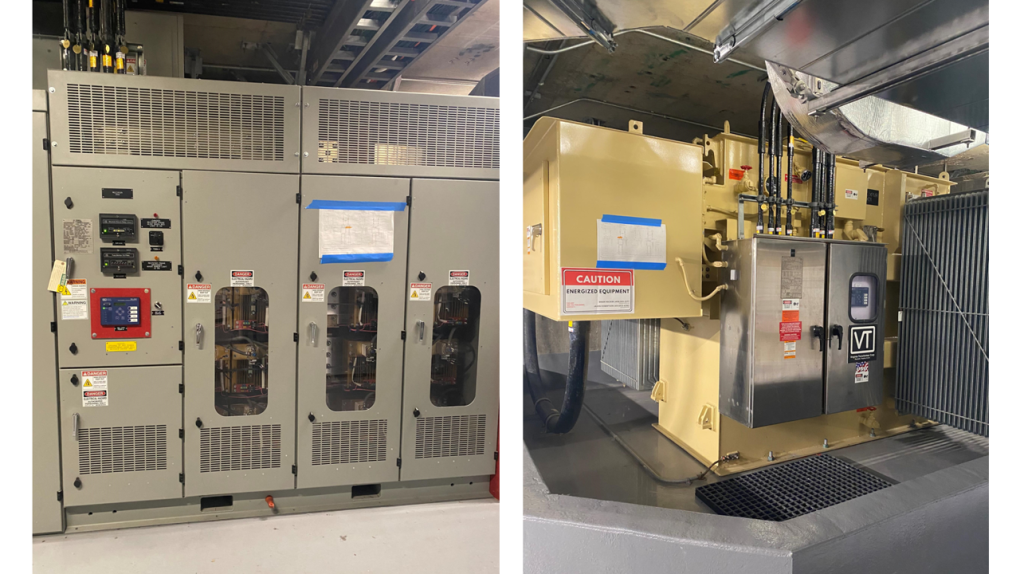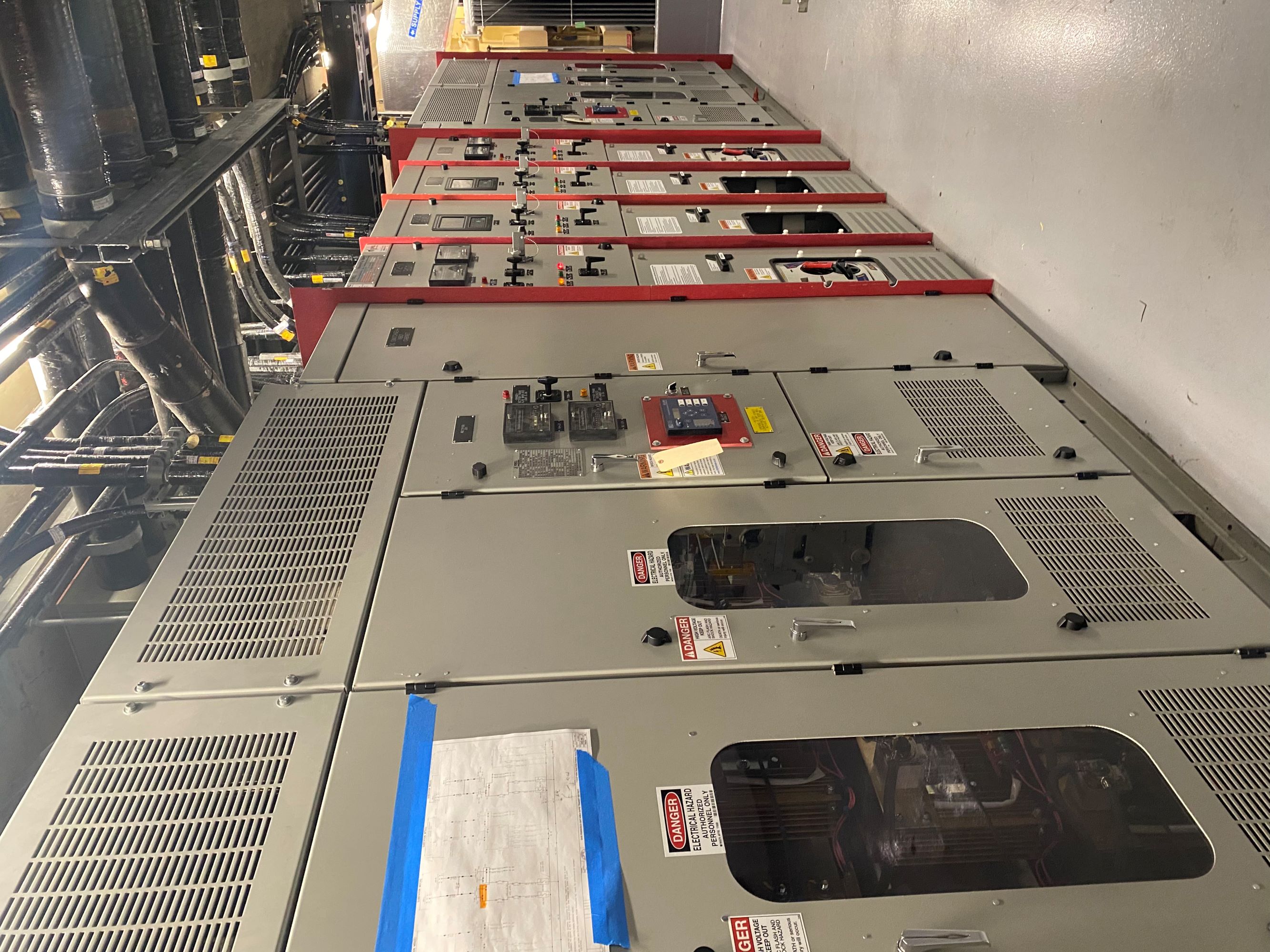"A great feat": BART constructs new power substation in one of its busiest stations

Photos of the completed substation at Civic Center Station.
To read more stories about BART infrastructure, visit bart.gov/railtales.
For the first time since the original BART system was built in the 1960s, BART has completed construction on a brand-new substation facility in the system’s core that is already providing benefits to riders.
Energized in late April, the state-of-the-art traction power substation at Civic Center Station increases the energy available to power BART trains in San Francisco by nearly 18%. (Note: 86% of BART’s contracted energy as of 2024 is greenhouse gas-free.)
“We haven’t done anything like this in the fifty-plus years since BART was constructed,” said Myat San, Chief Infrastructure Delivery Officer, who has been involved in the yearslong project from start to finish. “We’ve replaced substations but never built a facility at an already-constructed station. This is a great feat.”
The energization of the substation provides immediate, tangible benefits to BART riders in the substation’s operating area of Downtown San Francisco, the busiest section of the BART system.
“The substation increases reliability, redundancy, and operational flexibility, which are important for a system as large and complex as BART,” said Javed Khan, Group Manager, Capital Projects. “It also has modern features, including advanced monitoring and diagnostic capabilities.”
This means improved substation performance. If a problem does arise, BART and the Operations Control Center can quickly identify and pinpoint it and dispatch technicians to repair and restore the substation. BART can also source power from the new substation to keep trains running and mitigate system impacts, such as service delays.
“BART’s improvements to station lighting and fare gates are very visible, but with substations, you don’t see the benefits with your own eyes,” said San. “But even if you don’t see these substations, you experience them. They are the unspoken heroes of the system."
The increase in available power from the new substation will also give BART the future capability to run additional trains through the Transbay Tube as part of BART’s Transbay Corridor Core Capacity Program (TCCCP).
What exactly is a traction power substation? It's the equipment that converts energy from PG&E to the electrified third rail that provides the motive power for BART trains to run.
The Civic Center substation has two transformers, each pumping 5 megawatts and running in tandem. The project is one part of TCCCP, a series of strategic investments that will enable BART to increase the number of trains it operates at any given time. TCCCP will see the construction of five new substations, as well as an additional substation at BART’s Hayward Maintenance Complex. These will provide the energy needed to power additional trains, with the objective of running up to thirty ten-car trains per hour in both directions of the Transbay Tube. The project is funded by voter-approved Measure RR and Federal Transit Administration grants.
The project team chose to construct the first of the five new substations at Civic Center because Downtown San Francisco is the busiest part of the BART system with the highest train frequencies. But building a huge substation facility beneath Market Street during the few hours each night that the BART system is closed is as difficult as it sounds.
“We had to get huge components – switch gears, cabinetry, breakers, transformers – into a hole in the ground in the middle of one of the busiest streets in the Bay Area using a 106-foot crane,” said Khan. That’s a tall task.
Some of the equipment weighed 37,000 pounds, and all of it had to be carefully maneuvered into a 15-by-15-foot access hatch cut from Market St. into the station one 3,000-pound section at a time. In some instances, there was less than a foot of clearance between the equipment and the surrounding walls.
A stretch of Eighth St. intersecting Market St. was closed just for this day. Though the process of lowering the equipment took about 12 hours to complete, the project team had been preparing for the moment for more than a year. BART Communications chronicled the crane process in this 2022 article.
The planning and design phases began long before the crane rolled onto Market St. After an initial TCCCP study was conducted in 2015, a consulting firm was brought in to help assess and develop the engineering designs, with inputs, reviews, support, and coordination from BART. The design phase was completed in about 1.5 years, after which the construction contract was put out to bid (also known as the procurement phase). Then came material delivery and construction.
In project management terminology, the space selected for the substation is known as a brownfield, meaning the site was already developed. Brownfield projects pose unique and sometimes unexpected obstacles as engineers must retroactively design and construct within the constraints of the space. A greenspace is like a blank piece of paper; a brownfield space is a paint by numbers.
The age of the BART system adds extra challenges. Building codes and standards have changed considerably since the 1960s and 1970s.

Avineet Garg, the BART project manager, said the team had to secure numerous permits and coordinate with multiple organizations, including the City of San Francisco, the California Public Utilities Commission (CPUC), the San Francisco Municipal Transportation Agency, PG&E, and local businesses.
An added obstacle: Many construction activities took place during what’s known as “the blanket,” or the three hours each night that BART trains aren’t running for passenger service.
“And once you build a new traction power facility, you can’t just start running it until it’s fully tested and confirmed ready to interconnect to the BART electrical grid,” said Juan Ulloa, Acting Superintendent of Power & Mechanical Maintenance.
Thus came the final phase of testing and commissioning. This took about six months, primarily to ensure the newly built systems and equipment were performing as per design and safely integrated with the existing systems and equipment. This culminated in the CPUC-administered, three-day confidence runs during passenger service.
Once the CPUC greenlighted energizing the substation, it started a job that it will hold for many, many years: powering BART trains that carry thousands of people where they need to go each day.
“The coolest part of this process is seeing the thing go from paper to constructed,” said Khan, reflecting on the project. “It’s a once-in-a-lifetime opportunity to be part of this project from start to finish.”
More opportunities lay ahead for Khan and his colleagues. Next up: a brand-new substation at Montgomery St. Station. The project is moving swiftly towards completion and energization.